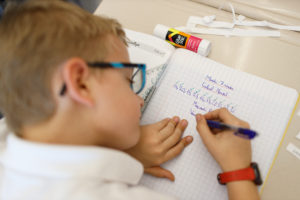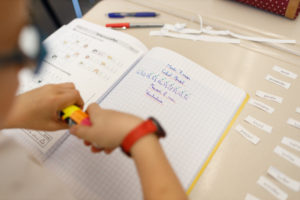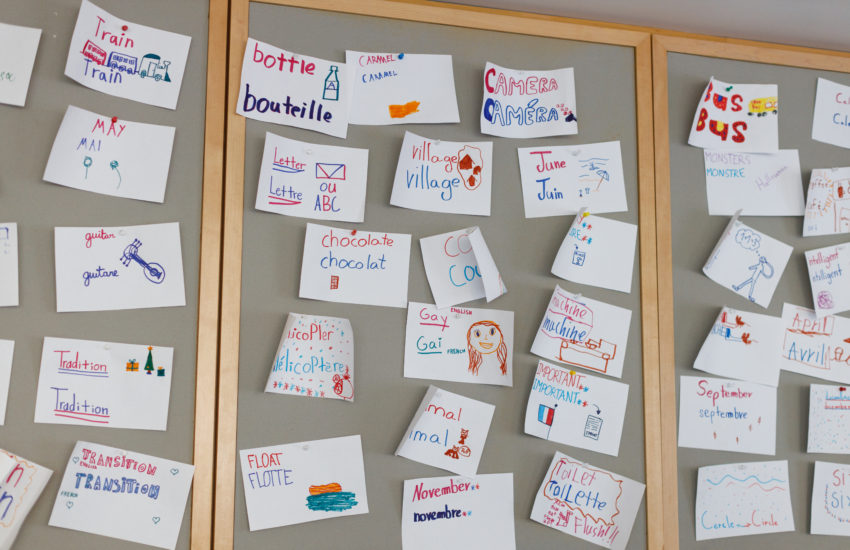Becoming a confident writer is something that every child is capable of. Learning to write in a bilingual environment can be challenging for young children who are developing their voice and writing habits. However, there are many ways to encourage and foster a successful writing environment at home. The following tips will not only strengthen your child’s writing habits and routines, but also make writing an enjoyable and inclusive experience for the whole family.
1. Encourage them to keep a journal (and keep one yourself!)
 Journals are a great tool that allow students to write about authentic topics while also practicing newly learned skills and techniques. This type of writing is most ideally child-focused. If children are encouraged to write about topics they care about in a style they want, their writing will be authentic. This builds voice, motivation, and investment in children. Journal writing gives children the freedom to write creatively without worrying about spelling, grammar, and organization—they only need to focus on their ideas and their passion, which encourages students to take risks. Students can write in any language they feel most comfortable in. They are writing for themselves, not a teacher. When you have a journal of your own, your child has a role model for writing and you can create another connection with your child.
Journals are a great tool that allow students to write about authentic topics while also practicing newly learned skills and techniques. This type of writing is most ideally child-focused. If children are encouraged to write about topics they care about in a style they want, their writing will be authentic. This builds voice, motivation, and investment in children. Journal writing gives children the freedom to write creatively without worrying about spelling, grammar, and organization—they only need to focus on their ideas and their passion, which encourages students to take risks. Students can write in any language they feel most comfortable in. They are writing for themselves, not a teacher. When you have a journal of your own, your child has a role model for writing and you can create another connection with your child.
2. Talk them through brainstorming.
 Brainstorming is a key first step of the writing process. It is a time when students plan, prepare, and collect their thoughts and ideas. Ask your child questions as they brainstorm to prompt more details and help them clarify their ideas. Suggest that they make a web or a chart to organize their thoughts. Have them tell you their story before they start writing and help them jot down ideas as they talk.
Brainstorming is a key first step of the writing process. It is a time when students plan, prepare, and collect their thoughts and ideas. Ask your child questions as they brainstorm to prompt more details and help them clarify their ideas. Suggest that they make a web or a chart to organize their thoughts. Have them tell you their story before they start writing and help them jot down ideas as they talk.
3. Ask questions about their favorite books.
Every time your child reads a book by an author that they love, they are looking at a model for their own writing. Engaging in conversation and highlighting what authors have done well makes students excited to try these things in their own writing. Good authors use techniques in their writing to show how the characters are feeling. They include humor and make their readers laugh. Authors also use style techniques like font change to emphasize a part of the text. Ask what they like about their favorite authors and encourage them to try to do something similar.
4. Ask them to reread their writing out loud.
 Editing and revising are important steps in the writing process. Asking children to read their writing aloud is a trick used by teachers before they begin conferences, or one-on-one check ins, with their students. When a child reads their work aloud to themselves or another person, they often catch their own mistakes. They can “hear” when something sounds off or wrong. Sharing what they’ve written with people they care about also gives children pride in their work and an audience. Kids can “perform” their writing for siblings or relatives. Positive and supportive feedback is important for children.
Editing and revising are important steps in the writing process. Asking children to read their writing aloud is a trick used by teachers before they begin conferences, or one-on-one check ins, with their students. When a child reads their work aloud to themselves or another person, they often catch their own mistakes. They can “hear” when something sounds off or wrong. Sharing what they’ve written with people they care about also gives children pride in their work and an audience. Kids can “perform” their writing for siblings or relatives. Positive and supportive feedback is important for children.
5. Incorporate technology
Technology is a proven motivator for many children. While screen time must be monitored, technology is a great way to get your child excited about writing. Use an app such as Book Creator to create a professional looking book. Have your child doodle on the iPad after they write to design illustrations for their work. Allowing your child to type their work is not only great practice with the keyboard, but also gives them the opportunity to change the font, color, and size to give their writing personality and make it look exciting!
About the Author :
Ashley Benic and Brittney Kugler are teachers in the Primary English department who have personal and professional interests in writing. With the opportunity to work on a summer grant for the Lycée Français de New York, they researched how to support bilingual students in writing and explored best writing practices to be used in both Primary and Secondary. Ashley and Brittney presented clear and easily implementable strategies and tools to encourage writing production and fluency. Through their research and knowledge, they hope to make writing a positive experience for students and their families both in school and at home.


